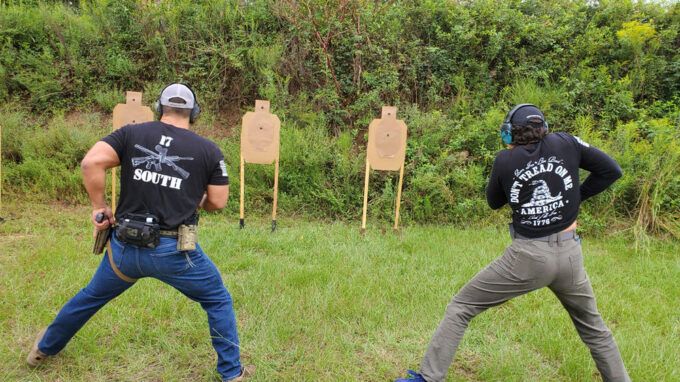It’s the responsibility of gun owners to train for proficiency in handling their preferred firearm. Are you preparing for competition, need it as a part of your job, or simply for self-defense? Regardless of your goal or how much you need to learn, it takes training, practice, and discipline to get to the skill level you want. Holding a gun and firing it is more challenging than one would think. Here are ways to learn and gain skills and knowledge on using firearms.
1. Train With The Experts
When you have a newly bought gun or have had it for a while, it’s essential to acknowledge that you must learn how to use it first. You may head over to an indoor public range and try to use it on your own, fire at targets, and keep missing. The problem is that practice isn’t enough without the supervision of a firearm expert. It’s not enough knowing how to pull the trigger. It’d help if you also increased your accuracy to hit the target.
Seek out your local firearms instructor or head to the nationally-recognized firing range. You can also research an instructor’s experience by checking a list of references, reviewing a resume, watching a class, or reading reviews on the individual. An experienced instructor can teach you more about using your firearms. The right firearm expert can provide quality instruction and make you more proficient. You could also click here for more information.
2. Concentrate On Accuracy

Source: inlandarms.com
You’ll find that it’s not enough to hit the target when training. Improving your skills means that you need to be consistent when hitting your target. You can start with short distances first. It’s challenging to overcome, but once you perfect the skill, you can begin sending your targets further to see if you can hit them. You can improve your overall accuracy in time.
3. Regular Practice
Practice is crucial in any skill that you want to perfect. Focusing on the proper technique and tips you learned in class helps you enhance your accuracy. It’s also crucial to be patient with yourself when you’re still learning and take note of the progress you make as you go along.
Drop by the shooting range regularly or look for other ways to practice safely. You can practice at least once a month, but if you can do more, such as weekly, the faster you’ll get better with your shooting skills and get to the level of proficiency you desire.
You can do dry-fire training, one of the best ways to practice the basics. It’s when you won’t be using loaded magazines or live ammo. Once you set up a safe space for practice, start practicing proper handling of your firearm. Go through the basic marksmanship skills, such as presentation, target acquisition, transition, and trigger press and control. Remember always to observe the four fundamentals of gun safety when practicing dry firing.
4. Train In Handgun Manipulation

Source: gtac.us
Your shooting accuracy also relies on how you manipulate a handgun. Handgun manipulation involves your grip, stance, climate, optics, trigger press, and follow-through. It also requires troubleshooting malfunctions fast. Handgun manipulation is a skill that all students must learn and train hard for. It means you must practice and develop those skills to use your gun the best way possible. Aside from enhancing your accuracy, it’d be best to practice handgun manipulation whenever you come to the firing range.
Training on your stance or how you stand can also impact your ability to hit the target. On the shooting range, start with a beginner-friendly stance. Separate your feet about as wide as your shoulders. If you’re right-handed, place your left foot forward, and the right should be slightly back. You can learn other stances, but this basic stance is best for the shooting range if you’re a beginner.
5. Work On Recoil Anticipation
Recoil anticipation can become a challenge for many shooters. Anticipating recoil can affect how you shoot because you think it’ll hurt. Another good reason to do dry-firing is to help build muscle memory to surpass recoil anticipation. If you tend to overthink recoil, pull the trigger as if you’re only dry firing and let the handgun do what’s it supposed to do. Remember that gun safety rules also apply to dry firing.
6. Ask For Feedback

Source: tacdynamics.com
Your journey to firearm proficiency also includes asking for constructive criticism that’ll help you improve your skill. Someone should be right there who can give you feedback. That’s also why getting proper instruction is better than learning to shoot on your own.
As much as you may want to think that you’re already doing good, overconfidence can lead to errors and overestimating your abilities. It’s better to adopt an attitude wherein you can acknowledge that there’s still more to learn when learning how to use firearms. Receptiveness to the advice of instructors and experienced individuals in and out of the firing range will help you improve your skills faster.
Take good feedback from well-respected experts and apply them when you’re practicing. It may also be helpful to log your training to record when you’ve been to the range and which handgun you used for practice. Also, put down which manipulation skill you worked on for the day. A training log may help you become more organized when working toward a specific goal.
It’s crucial to look for proper instruction on how to use firearms and apply what you’ve learned every time you use your gun. Having firearms and knowing how to use them also means that you can protect yourself and the people around you.
In Conclusion
To become proficient with firearms, you must seek professional instruction and practice regularly to improve your accuracy and handgun manipulation. Train your body to overcome recoil anticipation and ask for feedback from experienced shooters. When training, always observe safety rules. Regular practice with the right mindset and understanding that you’re holding a weapon will help you use it correctly when the time comes you need to use it for defense.







